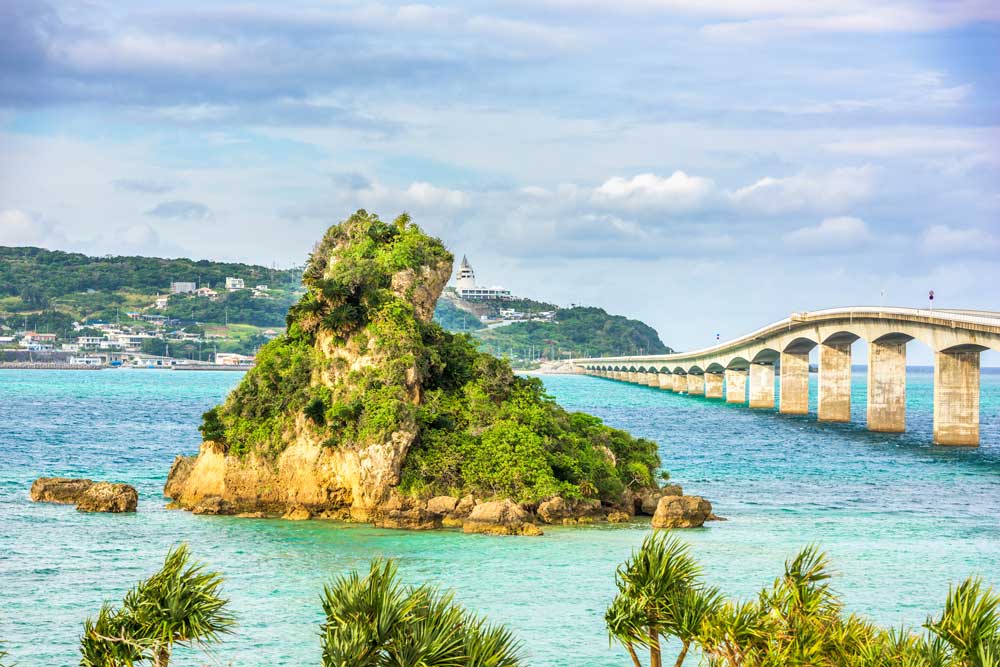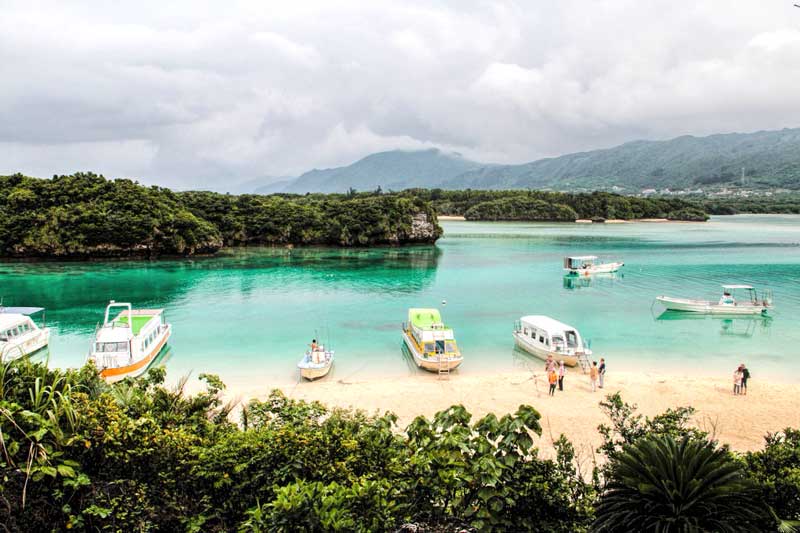If you’ve been around here for a while you’ll know that Japan is one of our top destinations to travel to and that we also love to relax and explore the Pacific Islands. The idea of combining the best of both into a single destination is just too perfect. An Okinawa trip can do just that.

Having been to Japans 3 largest islands (Honshu, Hokkaido and Kyushu) and one very small one (Miyajima) it’s high time we got around to exploring some of the others. An Okinawa trip has been on the wish list for quite some time but I recently came across this video that had just enough glimpses of the things I adore about Japan, and the island life that I was born for, to tempt me to nudge it even higher up the list.
Why Okinawa?
The Okinawa Islands are made up of 4 main islands and 3 groups of smaller islands. Okinawa Island is the largest and Japans 5th largest island at around 70 km long and 7 km wide. It’s home to well over half of Okinawas 1.3 million residents.
The sub-tropical island group is roughly equal distance from the rest of Japan and China and enjoys a sub-tropical climate with a annual average temperature of 20 degrees celcius. March and April are generally considered a great time to visit but it will depend on your preferences in temperature and activities.
The natural landscape is made up of coral reefs, limestone formations and lush rainforest making it ideal for active travellers like us who enjoy hiking, snorkelling or water based sports.
The scenic places and nature
An aspect that we love about exploring Japan that still surprises many people is the hiking and nature. As a country best known to many for it’s sprawling mega cities this is an aspect that is too often overlooked. From climbing Mt Misen in Miyajima to hiking the lush and beautiful Todoroki Gorge in Aomori , Japan is a country of scenic beauty.
Areas in Okinawa that are on my must see list include Daisekirinizan, part of the Yambaru National Park, a region of dramatic limestone cliffs, pinnacles and lush rainforest views. The park is huge but there are 4 introductory walking trails at around 1 kilometre each that give an overview of the different geographic features of the park, one of them is wheelchair accessible. The area is a little more remote but that means it’s not as crowded and the the birders among you will have a chance out here to spot the endangered Okinawa Rail.
The clear turquoise waters and abundant sealife are another big attraction of Okinawa. Being 640 kilometres south of Kyushu, the most southern of Japans 4 main islands, Okinawa has a sub-tropical climate. This makes it ideal to enjoy the sparkling clear sea surrounding the island group almost year round. The blue cave is the most famous snorkelling and diving spot located at the southern end of Okinawa Island. It’s known for the distinctive blue glow to the water, it’s a natural effected cause by the calcareous white sea floor reflecting the short blue light rays through the clear water.
Gyokusendō in the south of Okinawa Island is another famously scenic spot that would make my must see list. The limestone caves on top of a coral reef were carved out over 300,000 years ago. The cave system is huge, around 5km long yet it was only discovered in 1967. You can’t explore the full 5km as public access is restricted to an 890 metres long section that is carefully managed to protect its natural value but there’s still plenty to see within that, including over 1 million stalectites and stalagmites, it looks incredible.
The foodie life
In it’s food styles and specialties Okinawa is as different from the rest of Japan as it is the same. Such favourites as sushi, soba, tonkatsu, miso based soup and gyoza are still just as delicious and widely available but it’s climate influences the available ingredients bringing in many that are more common in south east Asia and across the Pacific Islands such as bitter melon, tropical fruits and taro.
There are some unique must trys to look forward to in Okinawa too. If you enjoy seaweed such as nori and wakame then the delicate crisp beads of umi-budō or sea grapes are a must.
Gōyā chanpurū is another signature local dish, it’s a stirfry using bitter melon, pork, vegetables, egg and tofu. Watch out that you order the pork version though, the American influence in Okinawa has seen Spam also used in this dish in place of fresh meats and to be honest that really doesn’t have the same appeal.
Soba is of course a favourite of mine and surprisingly given the sub-tropical climate the local dish is served with the noodles hot not cold as is common in hot weather across the rest of the country. The Okinawan soba is also made from wheat noodles rather than buckwheat as it is in the rest of Japan. It’s still presented in a soup with pork rib or pork belly, it sounds delicious and I’m ready to give that a try any time.
Customs and history
Okinawas history was distinct from Japan until the 17th century when it was brought under the Japanese feudal system and later annexed by Japan during the Meiji period. Those earlier influences of the Ryukyu Kingdom establishd in 1429 are still quite evident around the islands today.
You can visit the ruins of Urasoe Castle and royal tombs from the Ryukyu period a short distance north of Naha, the capital of Okinawa Island. While only ruins remain today this was once the largest castle in this medieval capital.
Something we do find fascinating in Japan as a whole is its Buddhist history. Some cities such as Kyoto are known for their historic temples but in Okinawa the history is no less impressive. Buddhism is thought to have been brought to Okinawa around 1260 AD and shortly after that Gakuraku-ji and Ryufuku-ji temples were founded. You can visit these temples not far from Urasoe Castle.
There are many reasons to visit Okinawa but the scenery, nature, food, customs and history will all feature on our itinerary. Have you been to Okinawa or do you plan to visit? What are your must see sites or activities on the islands?
